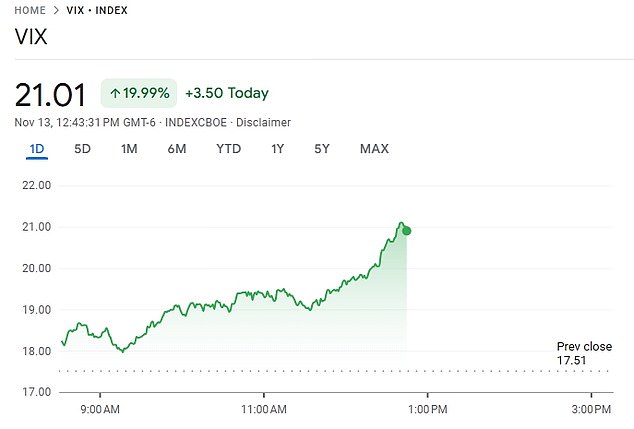Wall Street is having a rough Thursday.
By midday, all three major indexes — the Dow, Nasdaq, and S&P 500 — were deep in the red, down between 1.3 and 2.2 percent.
Only one big mover is in the green: the Volatility Index, or VIX — better known as Wall Street’s fear gauge. Around 2pm ET, it was up nearly 20 percent.
The VIX tracks how volatile investors expect the stock market to be over the next 30 days, based on options prices for the S&P 500.
When it spikes, it’s a sign investors are nervous; when it cools off, the market’s feeling pretty chill.
Today’s surge shows Wall Street is still on edge, as doubts about AI-fueled stock gains creep in.
Among the skeptics is Michael Burry, the Big Short investor who predicted the 2008 financial crash. Last week, it emerged he has now made a huge bet that Nvidia’s share price will fall.
Then, on Tuesday, Masayoshi Son, one of tech’s most–watched investors, revealed he quietly sold off all his Nvidia shares and most of his stake in T-Mobile last month.

The VIX, otherwise known as the fear index, has spiked by nearly 20 percent by midday trading
Both moves were read as a warning sign that the AI boom — the same one that has powered record stock gains for companies including Nvidia, Microsoft, and Palantir — might finally be wobbling.
Tech stocks have been hardest hit as jittery investors continued dumping the once-red-hot AI names, fearing their sky-high valuations have finally run out of steam.
The Nasdaq, which started the week on a strong footing, was on track for a third straight day of losses — dragged down by giants like Nvidia, Broadcom, and Google-parent Alphabet.
But, not everyone is panicking about the tech rout. Some analysts say the slump is simply the market catching its breath after months of AI mania.
‘It seems like a natural consolidation to me,’ Ron Albahary, chief investment officer at Laird Norton Wealth Management, told CNBC, calling the pullback ‘healthy.’
‘At some point, all this capital expenditure is going to actually manifest itself.’
Still, even companies that aren’t relying on AI are in the red today. Adding to the sell-off, traders slashed their expectations for a December Fed rate cut.
The odds fell from nearly 63 percent yesterday to under 50 percent today, CME data shows.
Lower interest rates are good for stocks because they make borrowing cheaper — for both businesses and ordinary Americans, who can then spend more.
This is a breaking news story. Updates to come.
